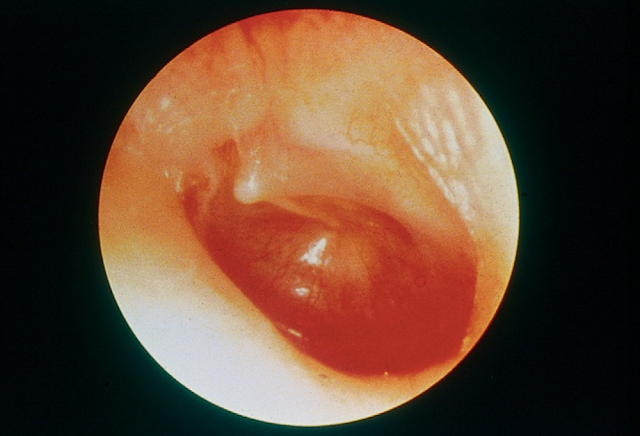Acute otitis media
✓ Acute otitis media is common and frequently bilateral. Most children will develop one or more episodes typically before they are 2 years old.✓ It can follow an acute upper respiratory tract infection and may be viral orbacterial. A viral infection is short-lived (1 or 2 days) and often accompanied by some general features of an upper respiratory infection, e.g. pharyngitis and a runny nose.
Symptoms
Earache
Earache (otalgia) may be slight in a mild case, but more usually it is throbbing and severe. The child may cry and scream inconsolably until the ear perforates, the pain is relieved and peace is restored.
Deafness
Deafness is always present in acute otitis media but if the infection is unilateral this can go unnoticed. It is conductive in nature and may be accompanied by tinnitus. In an adult deafness or tinnitus may be the first complaint.
Discharge
Pressure builds up in the middle ear and the drum ruptures. The child gets immedi- ate pain relief but the parents notice a sticky discharge, often purulent. The perfora- tion formed in this way usually heals.
Signs
PyrexiaThe child is flushed and ill. The temperature may be as high as 40 °C.
Tenderness
There is usually some tenderness to pressure on the mastoid bone.
The tympanic membraneThe tympanic membrane varies in appearance according to the stage of the infection (Fig. 8.1). In early infection the drum is red, it becomes tense and bulging and may perforate with discharge of pus. Mucoid (sticky) discharge from an ear must mean that there is a perforation of the tympanic membrane. There are no mucous glands in the external canal. Otoscopy and interpreting the findings can be difficult in a fractious child.
Pathology
Acute otitis media is an infection of the mucous membrane of the whole of the middle-ear cleft Eustachian tube, tympanic cavity, mastoid air cells.
The bacteria responsible for acute otitis media are: Streptococcus pneumoniae, Haemophilus influenzae, Moraxella catarrhalis. Group A streptococci and Staphylo- coccus aureus may also be responsible.
Figure 8.1 The appearance of the drum in acute otitis media.
The sequence of events in acute otitis media is as follows:
1 Organisms invade the mucous membrane causing inflammation, oedema, exu- date and later pus.
2 Oedema closes the Eustachian tube, preventing aeration and drainage.
3 Pressure from the pus rises, causing the drum to bulge and perforate.
4 Most cases resolve completely. A small number cause complications (see Chapter 11) or persistent perforation.
Treatment
Analgesics
Adequate analgesia is essential. Otitis media is painful and causes much misery. Simple analgesics, such as paracetamol, should suffice but use adequate doses. Avoid the use of aspirin in children because of the risk of Reye’s syndrome.
Antibiotics
Antibiotics are commonly prescribed but critics point out that they should be withheld at least in the early stages as the great majority of cases are self- limiting, and often viral. Widespread antibiotic use promotes the development of bacterial resistance. Some GPs give a prescription which the parents only need to get if the child doesn’t improve in a day or so (Safety Net Antibiotic Prescription or ‘SNAP’). A mild viral infection can be managed in this way but remember that otitis media is still a serious disease with potentially devastating complications. Make sure you are able to see the child for review and if in any doubt don’t hesitate to use antibiotics. Penicillin or cephalosporins such as cefaclor remain the drugs of choice in most cases. There is no need for expensive third and fourth generation cephalosporins in the treatment of uncomplicated otitis media.
Myringotomy
This is the creation of a small perforation in the eardrum very rarely necessary when bulging of the tympanic membrane persists, despite adequate antibiotic therapy or if there are complications. It should be carried out under general anaesthesia in theatre by an ENT surgeon. The ear may already be discharging when the patient is first seennature’s myringotomy.
Further management
Acute otitis media is not cured until the hearing and the appearance of the mem- brane have returned to normal. This can take several weeks and a persistent effusion of fluid in the middle ear is especially common in children.
If there is no resolution suspect:
1 the nose, sinuses or nasopharynx; infection may be present;
2 low-grade infection in the mastoid cells.
Recurrent acute otitis media
Some children are susceptible to repeated attacks of acute otitis media. This causes a lot of distress to parents and children but usually resolves as the child gets older. Breast-feeding and avoidance of passive smoking help protect children. Very rarely there may be an underlying immunological deficit that will need to be investigated. If the attacks persist, grommet insertion or long-term treatment with low-dose antibiotics may prevent further attacks.






ليست هناك تعليقات:
إرسال تعليق
من فضلك اكتب تعليقا مناسبا